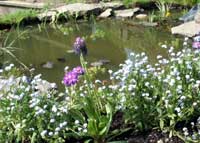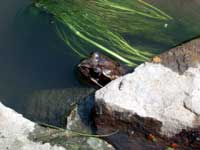
Wildlife pond
Applying the finishing touches to your pond
Finish your garden pond as you wish - local random stone and grass looks more natural for a wildlife pond. For safety, set the stone on a mortar mix and check for level. A grass edge will eventually hide the liner and provide shelter for your baby frogs within the pond. |
 |
Tap water is high in chlorine which could harm your pond life. The chlorine content will disappear before your pond is colonized, although our first adult frogs appeared within a week of the pond being filled! A bucketful of water from an established pond will give your pond a 'kick start' but give a week for the chlorine to evaporate.
 |
Flat stones lowered, carefully, into the water will give your pond creatures somewhere to hide from predators, including the inevitable heron. A shallow pebble beach will allow small animals safe access to the water. Large pavings round a wildlife pond are best avoided, as frogs can stick to hot stones and then dehydrate. |
Outside the pond you can use spare liner, punctured with holes to create a mini bog garden for moisture loving plants. Tall grasses, logs, large stones set one on top of the other, and planting round the back edge of your pond will encourage insects and animals and create a hiding place for your amphibious pond life.
All ponds need a balance to keep the water clear. This is achieved with pond plants.
Construction Pages
Page 1 Some considerations |
Page 2 Wildlife or Fish? |
Page 3 Pond Materials |
Page 4 Get Digging! |
Page 5 Pond Liner |
You are on page 6 of 8 |
Page 7 Plants - oxygenators |
Page 8 Plants - Marginals |
Frogs, frogspawn & tadpoles - page [1]
[2]![]() Main
Pond Page
Main
Pond Page